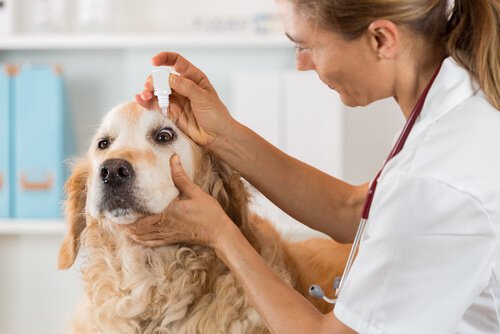What Causes Dogs to Tear?


Written and verified by the lawyer Francisco María García
The only living creatures that cry to express their emotions are human beings. Your dog may produce a lot of tears, but that doesn’t necessarily mean it’s anything more than a natural physiological response. Sometimes it doesn’t even mean anything is wrong with your pet.
Emotions in dogs
“Man’s best friend” doesn’t cry out of sadness or happiness., but that doesn’t mean he can’t express emotion. In fact, dogs tend to externalize feelings quite clearly.
Dogs make use of their sounds to show sadness, loneliness, pain, or happiness. They whine when they are in physical pain or discomfort. They bark when they’re excited, afraid, or threatened. Frantic tail wagging is related to happiness, though it can also indicate anxiety.
Just like humans, when animals don’t eat or barely move, it’s a sign of depression and sadness. In order to understand their emotional state, keep in mind that their expressions can also mislead how they’re feeling towards the world. Regardless of whether they’ve produced tears or not, they can use them to show happiness or sadness.
Tears: the eyes’ first line of defense
The primary function of tears in dogs is to protect the eyes and keep them hydrated. In the same vein, tears help expel any foreign bodies that get lodged near the eyeball.
Drastic changes in weather or strong gusts of wind can also trigger tears. When your dog’s tear production always increases during certain times, don’t think of it as a medical problem. Rather, it’s a sign that his eyeball’s defense mechanisms are doing their jobs.
Breeds
Also keep in mind that different breeds, might be more inclined to have a greater tear production. Such breeds include those with large eyes in comparison to head size, such as Chihuahuas or Shih Tzus. Also, breeds with a lot of hair around the eyes, such as Poodles or Malteses.

When your dog’s tear production might be a warning sign
If your dog’s tearing is constant and excessive, and the liquid isn’t transparent, take your pet to the vet in order to run some tests. These symptoms may take place due to a variety of reasons:
Wounds in the eye, or the presence of foreign objects
Unlike emotions, when it comes to the presence of a strange object in the eye – like a speck of dust – dogs produce liquid tears just like humans. The same thing takes place when the cornea is torn or damaged.
Allergies
In addition to tear production, allergic reactions might cause inflammation and redness around the entire eye ball. Your dog might have an excessive amount of crust in his eyes, perhaps even to the point that opening the eye becomes difficult. Frequent sneezing and coughing are also other signs.
Infections
This can be notices when a dog has excessive tearing and crust production, abundant yellow or green secretions appear. Another symptom of an eye infection is irritation in the eyeball and the corners of the eyelids.
Pink Eye
Pink eye in dogs can be caused by having dry eyes, environmental irritation, or poorly formed eyelids. It can also be a symptom of a more serious issue such as distemper or hepatitis.

What to do when your dog experiences excessive tearing?
If your dog is crying too much, and has any of the aforementioned symptoms, you should go talk to your veterinarian. The doctor can evaluate the affected area, determine the problem, and prescribe a treatment plan.
While waiting for medical evaluation, there are a few considerations to keep in mind. Read the tips below:
- Wash his eyes with lukewarm water, without rubbing them.
- If you can’t see a tear in the cornea or an injury to the eyelid, you can use a gauze pad dipped in chamomile tea as a physiological saline solution.
- Remove anything in the house that could be causing the allergic reaction. This includes air fresheners or cleaning products.
The only living creatures that cry to express their emotions are human beings. Your dog may produce a lot of tears, but that doesn’t necessarily mean it’s anything more than a natural physiological response. Sometimes it doesn’t even mean anything is wrong with your pet.
Emotions in dogs
“Man’s best friend” doesn’t cry out of sadness or happiness., but that doesn’t mean he can’t express emotion. In fact, dogs tend to externalize feelings quite clearly.
Dogs make use of their sounds to show sadness, loneliness, pain, or happiness. They whine when they are in physical pain or discomfort. They bark when they’re excited, afraid, or threatened. Frantic tail wagging is related to happiness, though it can also indicate anxiety.
Just like humans, when animals don’t eat or barely move, it’s a sign of depression and sadness. In order to understand their emotional state, keep in mind that their expressions can also mislead how they’re feeling towards the world. Regardless of whether they’ve produced tears or not, they can use them to show happiness or sadness.
Tears: the eyes’ first line of defense
The primary function of tears in dogs is to protect the eyes and keep them hydrated. In the same vein, tears help expel any foreign bodies that get lodged near the eyeball.
Drastic changes in weather or strong gusts of wind can also trigger tears. When your dog’s tear production always increases during certain times, don’t think of it as a medical problem. Rather, it’s a sign that his eyeball’s defense mechanisms are doing their jobs.
Breeds
Also keep in mind that different breeds, might be more inclined to have a greater tear production. Such breeds include those with large eyes in comparison to head size, such as Chihuahuas or Shih Tzus. Also, breeds with a lot of hair around the eyes, such as Poodles or Malteses.

When your dog’s tear production might be a warning sign
If your dog’s tearing is constant and excessive, and the liquid isn’t transparent, take your pet to the vet in order to run some tests. These symptoms may take place due to a variety of reasons:
Wounds in the eye, or the presence of foreign objects
Unlike emotions, when it comes to the presence of a strange object in the eye – like a speck of dust – dogs produce liquid tears just like humans. The same thing takes place when the cornea is torn or damaged.
Allergies
In addition to tear production, allergic reactions might cause inflammation and redness around the entire eye ball. Your dog might have an excessive amount of crust in his eyes, perhaps even to the point that opening the eye becomes difficult. Frequent sneezing and coughing are also other signs.
Infections
This can be notices when a dog has excessive tearing and crust production, abundant yellow or green secretions appear. Another symptom of an eye infection is irritation in the eyeball and the corners of the eyelids.
Pink Eye
Pink eye in dogs can be caused by having dry eyes, environmental irritation, or poorly formed eyelids. It can also be a symptom of a more serious issue such as distemper or hepatitis.

What to do when your dog experiences excessive tearing?
If your dog is crying too much, and has any of the aforementioned symptoms, you should go talk to your veterinarian. The doctor can evaluate the affected area, determine the problem, and prescribe a treatment plan.
While waiting for medical evaluation, there are a few considerations to keep in mind. Read the tips below:
- Wash his eyes with lukewarm water, without rubbing them.
- If you can’t see a tear in the cornea or an injury to the eyelid, you can use a gauze pad dipped in chamomile tea as a physiological saline solution.
- Remove anything in the house that could be causing the allergic reaction. This includes air fresheners or cleaning products.
This text is provided for informational purposes only and does not replace consultation with a professional. If in doubt, consult your specialist.







